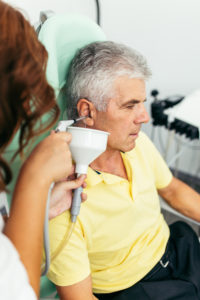What is Ear Irrigation?
 It goes without saying that our ears play a vital role in our everyday lives, allowing us to process the sounds of the world around us. The ear has a way of protecting itself and the delicate inner workings through the use of earwax to grab hold of dirt, bacteria, or other foreign materials. Unfortunately, too much earwax can do more harm than good, lowering our ability to hear clearly and cause earaches. Thankfully, there is a safe and effective way to remove excess earwax: ear irrigation.
It goes without saying that our ears play a vital role in our everyday lives, allowing us to process the sounds of the world around us. The ear has a way of protecting itself and the delicate inner workings through the use of earwax to grab hold of dirt, bacteria, or other foreign materials. Unfortunately, too much earwax can do more harm than good, lowering our ability to hear clearly and cause earaches. Thankfully, there is a safe and effective way to remove excess earwax: ear irrigation.
Ear irrigation is a safe and rather simple process with minimal side effects. Prior to the treatment, a physician will look into the ear to verify it is simply a buildup and not part of a more serious issue. A syringe-like tool will then be used to flush liquid (water or a water/saline mixture) into the ear to flush the wax out.
Although this process is safe, it should not be performed if you have any damage to your eardrum, have tubes in your ears, a current ear infection, or a weakened immune system. It is important to note that the procedure does carry some slight risks. The most common is an ear infection caused by inflammation. If the wax becomes more compacted during the procedure, or fluid becomes trapped in the canal increasing pressure, the eardrum could become perforated. In very rare cases, patients could experience vertigo or deafness.
Earwax does serve a purpose, keeping the ear canal moisturized, creating a waterproof barrier, protecting against infection, and removing dust and debris, and typically works its way out through daily movement of the jaw. Earwax buildup can be harmful over time or indicate other health issues, so if it is persistent, be sure to visit your doctor for an evaluation.
Having plugged ears is a frustrating issue, making everything sound muffled or quiet. Don’t sit around hoping it will remedy itself, or worse – try to fix it yourself – as it could lead to serious injury. Instead, visit us for safe, thorough ear irrigation.




